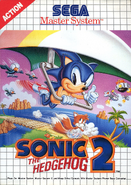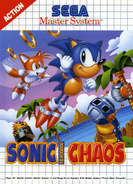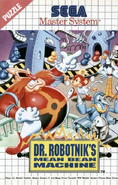Information in this article is about real-life people, companies, and objects, which do not relate to the in-universe Sonic series. |
The Sega Master System is a home video game console introduced by Sega in 1986, and was capable of 8-bit graphics and sounds. It was a rival to the very successful Nintendo Entertainment System (NES). The Master System is regarded as being superior to the NES in terms of general system capabilities[4] but the system eventually failed to gain enough attention in both North America and Japan.
However, it was successful in Brazil and Europe. Its lifespan was long enough to see four Sonic games (except Brazil which has five sonic games), before its discontinuation in 1991 in North America, 1992 in Japan, and 1996 in Europe. Except in Brazil, where this console remains produced to this day due to the massive popularity of this console in that country.[5]
The Sega Game Gear is based on the Master System's architecture, resulting in the handheld and game console being cross-compatible in certain titles and hardware. Due to the Game Gear's slight technological edge over the Master System however, any title ported to the Master System results in a minor graphical downgrade.
List of Sonic games
- Sonic the Hedgehog
- Sonic the Hedgehog 2
- Sonic Chaos (Europe only)
- Dr. Robotnik's Mean Bean Machine
- Sonic the Hedgehog Spinball
- Sonic Blast (Brazil only)
Characters Introduced
Box artwork gallery
| Gallery |
|---|
Trivia
- The Master System so far is the only Sega system that had two completely different names on the same region.
- The Master System version of Sonic the Hedgehog 2 (8-bit) was only released in Europe and South America.
- The Master System VDP was based on a video display controller made by Texas Instruments named the TMS9918 which was used on the preceding Sega console, the SG-1000.
- The Master System version of Sonic Chaos was only released in Europe, while Sonic Blast was only released in Brazil by Tectoy.
- The Sega Master System makes regular cameo appearances in a now defunct Cartoon Network show, "Regular Show". Both console and controllers are exactly the same despite it apparently being mirrored.
- The Sega Master System has no exclusive Sonic games, as all games released for the Sega Master System have also been ported on the Game Gear.
- There are 318 games officially released for the Sega Master System.
- The Sega Master System had no region lock chip inside the hardware. This means owners can play any games from any region.
References
- ↑ Master System (Japanese). Sega Corporation. Archived from the original on July 16, 2014. Retrieved on 4 June 2018.
- ↑ Computer Entertainer. February 1987, page 13.
- ↑ J. Wardyga, Brian (6 August 2018). The Video Games Textbook: History • Business • Technology. CRC Press. ISBN 1351172344. "One of Sega's popular slogans for the Master System was "The Challenge Will Always Be There." In retrospect, this slogan was fitting for the company."
- ↑ McFerran, Damien (22 July 2014). Hardware Classics: Sega Master System. Nintendo Life. Retrieved on 19 February 2018.
- ↑ Smith, Ernie (27 July 2015). Brazil Is An Alternate Video Game Universe Where Sega Beat Nintendo. Retrieved on 1 March 2018.
Template:Video game systems






